Though Farmers’ Meets are nothing new in themselves, Karshakasabha conceptualized by the Department of Agriculture Development and Farmers Welfare, Kerala, has got new elements in it, making it innovative. Dr Sreeram Vishnu explores the functioning of Karshakasabhas in this good practice note.
CONTEXT
Local level planning for agricultural development has always been emphasized by policy makers to ensure that local needs and priorities are reflected in development plans and priorities. For instance, the Strategic Research and Extension Plan (SREP) prepared by the Agricultural Technology Management Agency (ATMA), as well as the guidelines set by Rastriya Krishi Vikas Yojana (RKVY),as well as others, give due importance to local needs and priorities. However, these mechanisms proved effective only to a limited extent as the guidelines usually remain only on paper. Karshakasabhas are specifically set up to exclusively fill this gap – to understand local priorities and issues borne by farmers – and to address them urgently. This innovative idea is now being implemented by the Agriculture Department in a novel way to reflect farmers’ needs and development priorities. The events are conducted once per year and are directly funded by the Department of Agriculture with an aim to reach 10 lakh farmers in the state (Future Kerala 2018).
KARSHAKASABHA
Karshakasabhas are basically farmers’ meets akin to Gramsabhas, planned and conducted by the Department of Agriculture Development and Farmers’ Welfare (DoAD&FW), Kerala, in each Panchayat by the concerned KrishiBhavans.
Going by the Census of 2011, the population of Kerala is pegged at 334.06 lakhs with 14.04 lakh agricultural households, with operational holdings having an average size of 0.22 hectares (Government of Kerala 2016). The farm sector contributes about 10.88 percent of the total GDP of the state. Agricultural planning and policy making are supposed to be strong given the active engagement of farmers and people’s representatives at the grassroots level. However, political interests dominate many a time, overruling the core issues.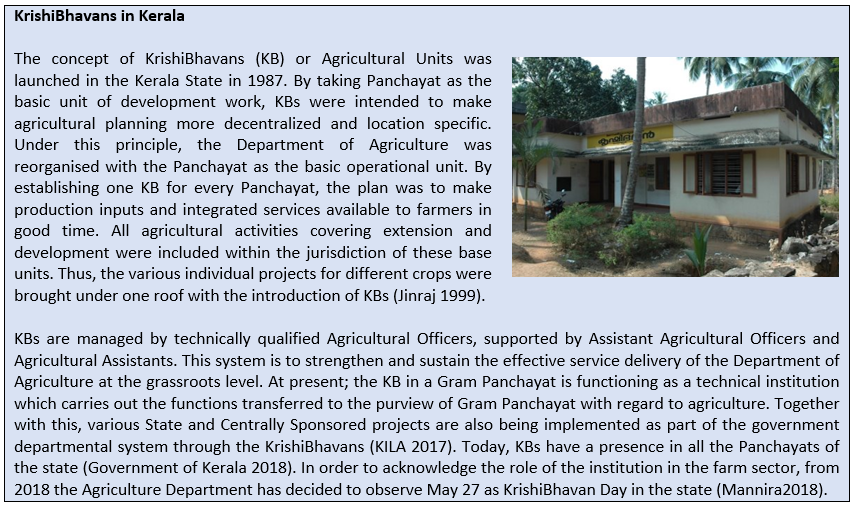
Karshakasabhas were planned to overcome this challenge so as to make planning and policy making more transparent. The basic objective of this programme is to gain inputs for local level agricultural development planning by conducting open discussions among the multi-stakeholders. These discussions, coordinated by the Agricultural Officers (at the Panchayat level) are expected to contribute to development planning and priority setting, and would highlight the constraints specific to each locale. These programmes are conducted in each ward of a Panchayat.
These meets were conceptualized as information delivery points to deal with the latest schemes and programmes of the Agriculture Department. Along with this, many vital services for the farmers, including organizing local markets to sell local produce (Njattuvela Chanda in Malayalam), arranging for soil testing, farm machineries, plant clinic, etc., were also planned on the sidelines of this event (Future Kerala 2018). The event proved that many of the development priorities which are not attended to, or fulfilled by the senior administrators were brought to their attention.
A block-level meeting was conducted by the DoAD&FW under the supervision of the Assistant Director of Agriculture mainly to review the action points that emerged in the Kisansabhas in all Panchayats under his/her jurisdiction. Elected representatives, farmers, agricultural officers, assistant agricultural officers, etc., were the main invitees. Inputs from each Panchayat were compiled and presented separately before the audience. Discussions on key issues were also organized to highlight the common issues and possible solutions. Farmers’ suggestions were also invited to address the issues identified.
MAJOR SUGGESTIONS
 Farmers addressed many of the general issues which are aired at the ward level by most of the Panchayats as well as locally relevant issues pertaining to their own areas. Some of the remarkable suggestions – such as irrigation scheduling for the crops in a Panchayat in consultation with the officials of the Irrigation Department (where canal irrigation is practiced);halting the routine operations of MGNREGS workers during the peak agricultural season and diverting their activities to locally-relevant, field-specific jobs; need for more fund allocation to renovate the roads near agricultural fields to ensure smooth passage of farm machineries, etc.– found a place in the final draft.
Farmers addressed many of the general issues which are aired at the ward level by most of the Panchayats as well as locally relevant issues pertaining to their own areas. Some of the remarkable suggestions – such as irrigation scheduling for the crops in a Panchayat in consultation with the officials of the Irrigation Department (where canal irrigation is practiced);halting the routine operations of MGNREGS workers during the peak agricultural season and diverting their activities to locally-relevant, field-specific jobs; need for more fund allocation to renovate the roads near agricultural fields to ensure smooth passage of farm machineries, etc.– found a place in the final draft.
Increased incidence of wild animal attack and untimely/ill-timed availability of farm inputs, such as seeds and soil ameliorants, were some of the common issues raised by most of the farmers across different wards. Farmers also expressed their grave concern with increase in the cost of farm labor and pointed to the urgent need for small farm mechanization, and formation of labor banks at the Panchayat level. For instance during one Karshakasabha at Ananganadi Panchayat where this author is working, farmers suggested their willingness to form a labour bank after undergoing expert training,in order to address the challenge of labor shortage for crops like paddy and coconut. Apart from this, many potential projects such as the need and feasibility of implementing a lift irrigation scheme for a large area that would benefit many cultivators, were aired and deliberated upon during the discussion. Thus local administrators/ people’s representatives who participated in the event got a gist of the issues and development priorities of the farmers, while DoA got many crucial inputs for strategizing areas of focus for the future. In some instances, farmers asked the departmental officials to follow up on the development projects which had been sanctioned but were yet to be implemented. In this way, Karshakasabhas succeeded in highlighting many of the core development issues relevant to a particular locality, which had otherwise been sidelined since long.
LESSONS LEARNED
Karshakasabhas offered a number of lessons to the organizers.
1.Planning
Participatory planning of the event is of crucial importance for the successful conduct of Karshakasabha. The planning should be done by the agricultural officer of the Panchayat in consultation with the elected representatives of each ward as well as farmers. Preparing the time schedule for each locale and steps to publicize the event in advance are necessary in order to ensure adequate farmer participation.
2.Publicizing
Various social media platforms, print media,and prior group meetings were used effectively to ensure adequate publicity for the event. Local leaders and lead farmers should invariably be consulted and engaged at various stages of planning. Usually, at the Panchayat level, there is a forum viz., the Agricultural Development Committee (ADC) of which they are members. So conducting an ADC meeting for planning the Karshakasabhas would be much more effective at giving it adequate publicity. Rural youth clubs, women’s associations, and resident associations working in that locality should also be engaged in conducting the event.
3.Event Management
Karshakasabhas are to be conducted with proper arrangement of logistics and support services. The meeting venue should be a convenient place for the participants to assemble and discuss various issues. Meeting points can be public libraries/ schools and community halls at the local level. Moreover,  refreshments and incentives (which do incur a small cost), like vegetable seedlings/seed kits, can attract a bigger audience. Arranging for live demonstration of new technologies can also be an incentive for greater farmer participation. Further, by ensuring the participation of local leaders whilst organizing the event, more people can be reached.
refreshments and incentives (which do incur a small cost), like vegetable seedlings/seed kits, can attract a bigger audience. Arranging for live demonstration of new technologies can also be an incentive for greater farmer participation. Further, by ensuring the participation of local leaders whilst organizing the event, more people can be reached.
4.Documentation
For the Karshakasabha to be successful, proper documentation is necessary. The reports generated at each ward level could be compiled and made into a final document which will become the agricultural development plan for the Panchayat. These reports will become essential at a later stage, especially while conducting the block-level Karshakasabha.
5.Follow-up Action
Several issues were discussed during the ward-level meetings. These issues need to be sorted according to their priority. Issues which demand urgent attention/action should be taken up as early as possible (for example, actions required for cleaning the irrigation canal, in consultation with the Panchayat). Demands which can be met in the long term should be properly documented with a concrete action plan for its timely achievement.
During discussion sessions, the development priorities and problems reflected by the farmers can be brought to the attention of decision makers. For example, farmers at many places demanded that field bunds be strengthened before the rainy season, which can be done by engaging the workers under MGNREGS. Local leaders attending the Karshakasabhas can immediately take note of these demands (raised by the farmers), and take the necessary steps to engage the MGNREGS workers for these specific needs.
6.Challenges
Although the setting up of Karshakasabha is an innovative approach that further strengthens the linkages among the DoAD&FW and farmers, the mode in which Karshakasabhas were conducted was not devoid of operational hiccups. For instance, though the department is providing financial support to KrishiBhavans to operationalize Karshakasabhas at the rate of INR 1000 per ward, it is quite low. Further, the conditions framed for its expenditure lacks flexibility, which means the amount usually spent on arranging the logistics/ incentives for the farmers must be spent equally in all wards irrespective of the number of participants! This poses hurdles to the smooth conduct of the event. Hence the agricultural officers need more flexibility with regard to spending the amount in each locale according to the level of participation.
 Secondly, there were problems which are beyond the capability of the KrishiBhavan to resolve. For instance, farmers in many places were complaining about the increased incidence of wild animal attacks in their fields, which are difficult to resolve by the DoAD&FW alone. (As the Karshakasabhas were held for the first time, there was limited participation from other department officials). Therefore, similar meets in future should involve other line department officials, those from veterinary, fishery, and soil and water conservation. Many a time this can offer better solutions to the problems faced by the farmers, which can be addressed by the joint activity of all these departments.
Secondly, there were problems which are beyond the capability of the KrishiBhavan to resolve. For instance, farmers in many places were complaining about the increased incidence of wild animal attacks in their fields, which are difficult to resolve by the DoAD&FW alone. (As the Karshakasabhas were held for the first time, there was limited participation from other department officials). Therefore, similar meets in future should involve other line department officials, those from veterinary, fishery, and soil and water conservation. Many a time this can offer better solutions to the problems faced by the farmers, which can be addressed by the joint activity of all these departments.
Thirdly, there may be some wards in the Panchayat where agricultural activities are at a minimum and the number of farmers, quite low. Farmer participation at meets would be very low in such wards, and would be a waste of time and resources for the department. Hence there should be a provision in the guidelines to club the Karshakasabhas of two or more wards, in such cases.
 Finally, the participation of other line departments in the Kisansabhas has been minimal. At the block level, Karshakasabhas were conducted following the events at the Panchayat level. For instance, the programme at the Shornur block (Palakkad District) was coordinated by the Assistant Director of Agriculture. All the policy and planning inputs received at the grassroots level were compiled and presented at the block level. The agricultural officers and officials of line departments were invited to the event to present the agricultural development priorities and problematic issues that had been identified during village level meetings.
Finally, the participation of other line departments in the Kisansabhas has been minimal. At the block level, Karshakasabhas were conducted following the events at the Panchayat level. For instance, the programme at the Shornur block (Palakkad District) was coordinated by the Assistant Director of Agriculture. All the policy and planning inputs received at the grassroots level were compiled and presented at the block level. The agricultural officers and officials of line departments were invited to the event to present the agricultural development priorities and problematic issues that had been identified during village level meetings.
The event was attended by the elected representatives from all the villages, the local MLA (Member of Legislative Assembly) as well as other development department officials. However, participation from the line departments was not impressive. Perhaps, having an impression that Karshakasabhas are purely an event of the DoAD&FW might have led to the minimal participation. After the block-level Karshakasabha later events were held at district and state levels.
CONCLUSION
Karshakasabhas, piloted for the first time by the DoAD&FW in 2018, proved to be a massive farmer outreach programme. The programme helped to get the inputs and development priorities for local action planning in agriculture by engaging local leaders. Moreover, the events became immediate information and service delivery points for the department. These sabhas offer an opportunity for the department to generate more demand and to identify the right beneficiaries for its various schemes, which otherwise would be cornered by a few individuals (Jinraj 1999). By addressing the operational glitches and ensuring the participation of line department officials, Karshakasabhas can be made a platform for convergent action for all line departments in the coming years. The outputs generated would undoubtedly go on to strengthen bottom-up planning in agriculture, as in the case of SREP and policy making at the grassroots level.
References
Future Kerala. 2018. All ward organized Karshakasabha. Accessed fromhttps://futurekerala.in/2018/04/18/all-wards-organized-karshakasabha/
Government of Kerala.2016.An analytical study on agriculture in Kerala.http://www.keralaagriculture.gov.in/pdf/a_s_06042016.pdf
Government of Kerala.2018. Agriculture development and farmer’s welfare. https://kerala.gov.in/agriculture
Jinraj PV. 1999. Performance evaluation of KrishiBhavanset-up in Kerala. Kerala Research Programme on Local Level Development, Centre for Development Studies. Discussion Paper No. 8. Accessed from http://www.cds.ac.in/krpcds/publication/jinraj.html
Kerala Institute of Local Administration. 2017. Administration Manual for transferred functions: KrishiBhavan. http://klgsdp.org/wp-content/uploads/2017/12/Krishibhavan-final.pdf
Mannira.2018.Karshakasabha.Accessed from http://mannira.in/ward-based-karshaka-sabha/?fbclid=IwAR3LxvPCL73fVzxuynviQPmgysRF5N5-VFecGWlmA9HMQ9YM7mc5DFtL5Ec
Dr SreeramV is an Agricultural Officer at Ananganadi Krishi Bhavan, Shornur Block, Palakkad, Kerala. (srieeram@gmail.com)


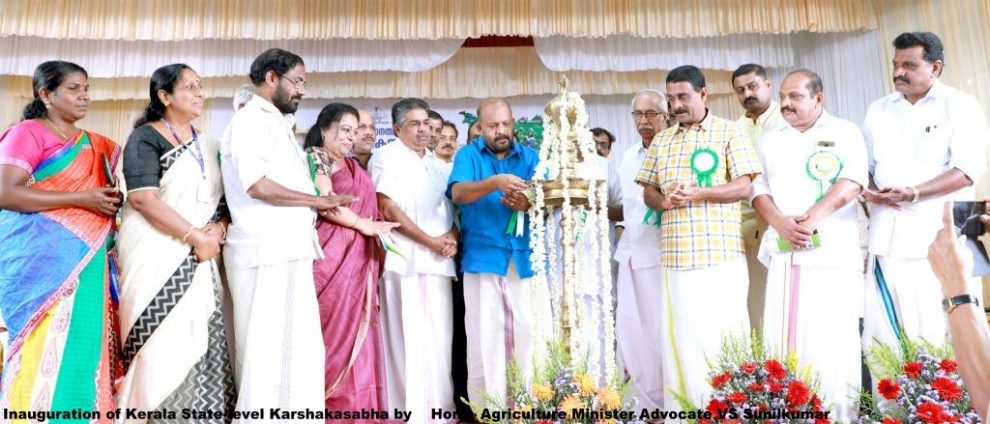

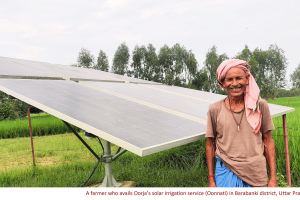
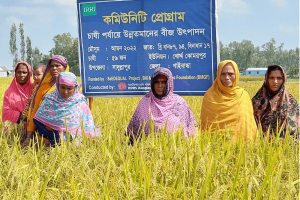
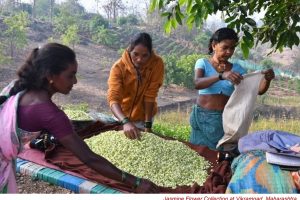
“Karshakasabhas is yet another promising attempt towards decentralized planning and action in agricultural development. It has good features like provision of critical agricultural services and supplies, information about new practices, etc. and its impact has to be seen in the next 2-3 years against its claims. We have a history of several such initiatives earlier but generally they failed to succeed against site level challenges. Hope and wish the new experiment will be an exception!”
“Complements to Dr.Sreeram for details on extension innovation. Karshakasabha,seems an innovative farmer participatory approach,though follow up and sustainability issues are still crucial. Involvement of Agricultural Committee of Panchayat and review by the Block level Asst.Director interlinks the systems. Important issues need to be documented for make them travel upward to the SAU and Secretary Agriculture for their intervention as deemed appropriate. Other submission is how to make it broad based, involving other line departments too. The frequency could be at least twice in a cropping season”.